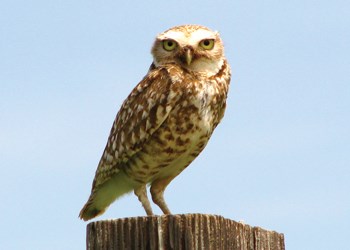The Burrowing Owl, one of Saskatchewan’s most well-known species at risk, has returned after spending the winter in Mexico and the southwestern United States (e.g., California to Texas). From mid-May until mid-June, these endangered owls are in the process of finding a mate, finding a suitable burrow, and laying and incubating their eggs.
Despite their name, Burrowing Owls do not dig a burrow themselves. Instead, they use abandoned burrows that have been excavated by ground squirrels, badgers, or other burrowing mammals. Each spring, female Burrowing Owls lay 6-14 eggs. Because there is thought to be less than 800 pairs nesting throughout Canada, the success of each nest is important to the survival and recovery of this species.
To ensure the nesting success of Burrowing Owls, it is important to minimize human activity around nest sites as much as possible; however, cattle grazing are not a disturbance or a concern for these owls. Kaytlyn Burrows, Habitat Stewardship Coordinator, explains: “The shorter grass in grazed pastures helps these owls to see potential predators. Additionally, Burrowing Owls often use cattle manure in their nests to absorb excess moisture, regulate burrow temperature, attract insects, and hide their scent from predators.”
If you discover Burrowing Owls in your pasture, do not fear! There are many advantages to having these owls on your land, especially the free pest control. “Burrowing Owls eat huge numbers of small mammals such as mice and voles, and the young feed primarily on grasshoppers,” says Burrows. “One nest of Burrowing Owls can consume over 1,000 rodents in a single season!”
Burrowing Owls are identifiable by their small size (~9 inches tall) and light and dark brown mottled plumage with white spots. Burrowing owls have long featherless legs, which can give them the appearance of walking on stilts. They have a round head, with large yellow eyes, and white ‘eyebrows’. During the nesting season, male burrowing owls can often be seen standing on mounds of dirt next to their burrows, or on nearby fence posts while the female incubates the eggs.
Nature Saskatchewan’s Operation Burrowing Owl works with landowners to protect and enhance Burrowing Owl habitat, and monitors Burrowing Owl numbers at enrolled sites. “Nature Saskatchewan is very fortunate to have so many passionate landowners participating in our programs and keeping a look out for species at risk, including the Burrowing Owl,” says Kaytlyn. Operation Burrowing Owl records sightings to help determine the population trend and distribution of the Burrowing Owl throughout Saskatchewan. “Without the voluntary efforts of landowners, land managers, and the general public, recovery of this unique prairie owl would not be possible” says Burrows. She encourages the public to “get out there this summer and explore, you never know what you will find.” If you are lucky enough to see a Burrowing Owl, Kaytlyn asks that you call Nature Saskatchewan’s toll-free Hoot Line, 1-800-667-HOOT (4668). “When you report a sighting you are playing an important role in Burrowing Owl recovery, and any information given is never shared without the landowner’s permission.”




